2008 AUDI TT ROADSTER warning light
[x] Cancel search: warning lightPage 154 of 316
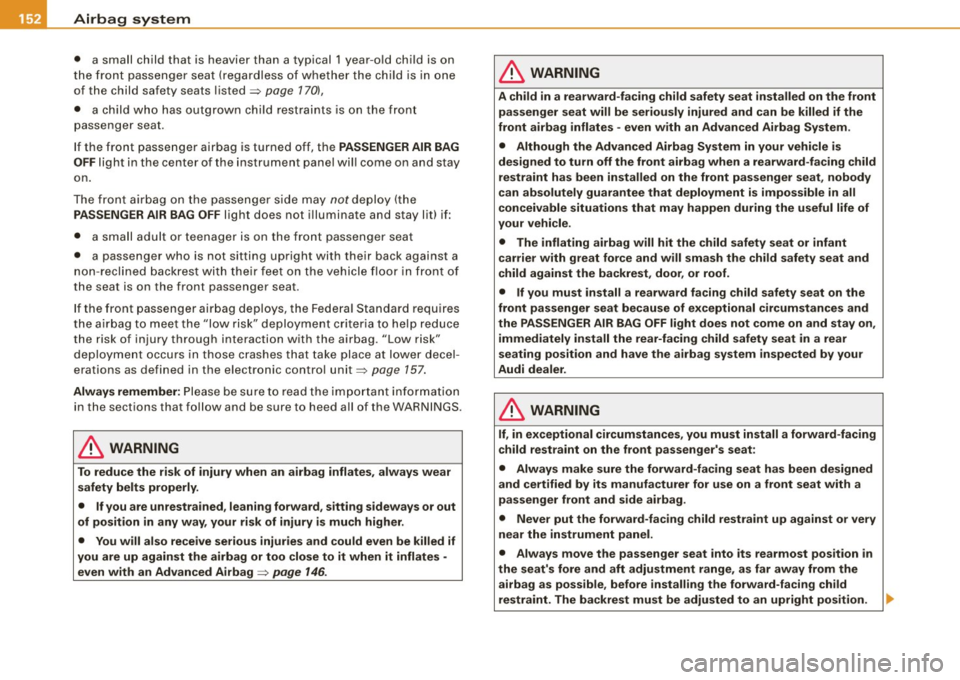
-Airbag system ----------------
•
a sma ll ch ild th at is heavi er than a typ ica l 1 ye ar-o ld child is on
th e front p assenger s eat (regar dle ss of whet her the child is in on e
of th e child saf ety seats listed~
page 1 70),
• a chil d w ho h as outgrow n chi ld re str ain ts is on the fr ont
passen ger seat.
I f the fr ont passe nge r ai rbag is tu rned off, the
PASSENGER AIR BAG
OFF
light in the cent er o f the instrum ent pan el wi ll come on and stay
o n.
The front airb ag o n the passenger si de may
not depl oy (the
PASSENGER AIR BAG OFF light does not illuminate and stay l it) if:
• a small ad ult or t eenage r is on the fr ont passenger sea t
• a passenger who is not sitting upright with their bac k against a
n o n-re clined back res t w it h th e ir fe et on th e ve hicle flo or in fr ont of
th e se at is on th e front pass enger s eat.
I f the front pas senger ai rbag depl oys, the Federa l Standard requ ires
the airb ag to me et the "low r is k" dep loy ment criter ia to h elp r educe
th e risk of in jury t hroug h in teraction w ith the a irbag. "Low risk"
de ploy ment occu rs in those c ras hes that ta ke p lace a t low er d ecel
erations as defined in the electron ic contro l unit~
page 157.
Always remember:
P lease be sur e to r ead the i mport ant info rm ation
in th e sections that follow and b e sur e to heed all of the WARN INGS.
& WARNING
To reduce the risk of injury when an airbag inflates , always wear
safety belts properly.
• If you are unrestrained , leaning forward, sitting sideways or out
of position in any way, your risk of injury is much higher.
• You will also receive serious injur ies and could even be killed if
you are up against the airbag or too close to it when it inflates ·
even with an Advanced Airbag~
page 146 .
& WARNING
A child in a rearward-facing child safety seat installed on the front
passenger seat will be seriously injured and can be killed if the
front airbag inflates -even with an Advanced Airbag System .
• Although the Advanced Airbag System in your vehicle is
designed to turn off the front airbag when a rearward -facing child
restraint has been installed on the front passenger seat , nobody
can absolutely guarantee that deployment is impossible in all
conceivable situations that may happen during the useful life of
your vehicle.
• The inflating airbag will hit the child safety seat or infant
carrier with great force and will smash the child safety seat and
child against the backrest, door, or roof .
• If you must install a rearward facing child safety seat on the
front passenger seat because of exceptional circumstances and
the PASSENGER AIR BAG OFF light does not come on and stay on ,
immediately install the rear-facing child safety seat in a rear
seating position and have the airbag system inspected by your
Audi dealer .
& WARNING
If, in exceptional circumstances , you must install a forward -facing
child restraint on the front passenger's seat :
• Always make sure the forward -facing seat has been designed
and certified by its manufacturer for use on a front seat with a
passenger front and side airbag .
• Never put the forward-facing child restraint up against or very
near the instrument panel.
• Always move the passenger seat into its rearmost position in
the seat's fore and aft adjustment range , as far away from the
airbag as poss ible , before installing the forward-facing child
restraint. The backrest must be adjusted to an upright position. ..,.
Page 155 of 316

Airbag syst em -----------------=~-
& WARN ING (co ntinued)
• Make s ure th at the PA SSENGER AIR BAG OFF light come s on
a nd sta y s o n all the tim e whene ver the ign ition i s sw itched on . •
Advanced Airbag System components
The front passenger seat in your vehicle has a lot of very important
parts of the Advanced Airbag System in it. These parts inc lude the
weight -sensing mat, sensors, wiring, brackets, and more. The func
tion of the system in the front passenger seat is checked by the e lec
tronic contro l unit when the igni tion is on. The control unit monitors
the Advanced Airbag System and turns the airbag indicator light on
when a malfunction in the system components is detected . The
function of the airbag indicator light is described in greater detail
below. Because the front passenger seat contains important parts
of the Advanced Airbag System, you must take care to prevent it
from being damaged. Damage to the seat may prevent the
Advanced Airbag for the front passenger seat from doing its job in a crash.
T he front A dvance d Airb ag Syst em con sis ts of th e
following:
• Crash sensors in the front of the vehicle that measure vehicle
acceleration/dece leration to prov ide information to the Advanced
Airbag System about the severity of the crash .
• An electronic control unit, with integrated crash sensors for front
and side impacts. The control unit "decides" whether to fire the
front airbags based on the information received from the crash sensors. The contro l unit a lso "decides" whether the safety belt
pretensioners should be activated .
• A dual -stage Advanced Airbag with gas generator for the driver
inside the steering wheel hub .
• A dual -stage Advanced Airbag and gas generator inside the
instrument pane l for the front passenger .
Controls and equip
ment Safety first Vehicle operation
•
A weight -sensing mat under the upholstery padding of the front
passenger sea t cushion that measures the total weight on the seat .
The information registered is sent continuously to the e lectronic
control unit to regula te dep loyment of the front Advanced Airbag on
the passenger side.
• An airbag monitoring syste m and indica tor l ight in the instru
ment cluster=>
page 157.
• The PASSENGER AIR BAG OFF light comes on and stays on in the
center of the instrument panel=>
page 157, fig. 133 and tells you
when the front Advanced Airbag on the passenger side has been
turned off .
• A sensor be low the safety belt latch for the front seat passenger
to measure the tension on the safety belt . The tension on the safety
belt and the weight registered by the weight -se nsing mat help the
control unit "decide" whether the front airbag for the front
passenger sea t should be turned off o r not =>
page 147, "Child
restraints on the front seat -some important things to know" .
• A sensor in the safety belt latch for the dr iver and for the front
seat passenger that senses whether that safety be lt is latched or not
and t ransmits this information to the electronic control unit.
& WARNING
Damage to the front pa ssenger seat can prevent the front airbag
fr om worki ng properly .
• Improper repair or di sa ssembly of the front pa ssenger and
dri ver seat will prevent th e Adv an ced Airbag Sy stem from func
tioning properly.
• Rep air s to the front p assenger seat must b e perfor med by qu al
ified and properly tra ined work shop per sonnel .
• Never remo ve the fro nt pa ssenger or dr iver se at from the
v ehi cle.
• Nev er remove th e uphol stery from the fron t pass eng er seat.
• Never disas semble or r emove p arts from the seat or di sconne ct
wires from it . ..
Vehicle care Do-it-yourself service Technical data
Page 157 of 316
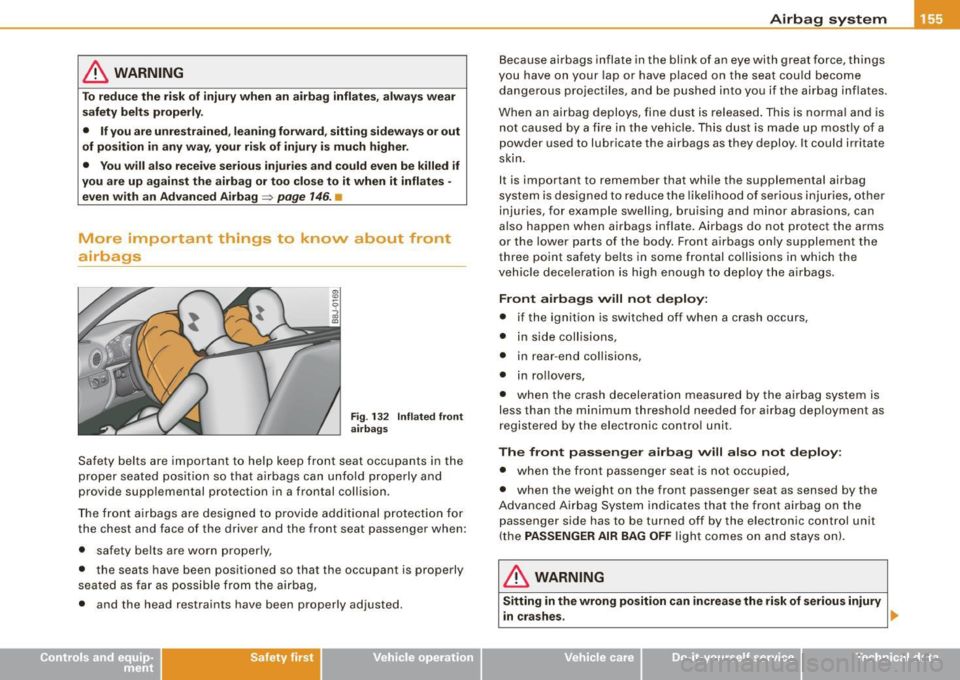
& WARNING
To reduce the risk of injury when an airbag inflates, always wear
safety belts properly.
• If you are unrestrained , leaning forward , sitting sideways or out
of position in any way, your risk of injury is much higher.
• You will also receive serious injuries and could even be killed if
you are up against the airbag or too close to it when it inflates ·
even with an Advanced Airbag~
page 146. •
More important things to know about front
airbags
Fig . 132 Inflate d front
airbags
Safety belts are important to help keep front seat occupants in the
proper seated posit ion so that airbags can unfold properly and
provide supp lemental protection in a frontal collision.
The front airbags are designed to provide additional protection for
the chest and face of the driver and the front seat passenger when :
• safety belts are worn properly,
• the seats have been positioned so that the occupant is properly
seated as far as possible from the air bag,
• and the head restraints have been properly adjusted .
Safety first
Airbag system
Because airbags inflate in the blink of an eye with great force, things
you have on your lap or have placed on the seat could become
dangerous projectiles, and be pushed into you if the airbag inflates .
When an airbag deploys, fine dust is released . This is norma l and is
not caused by a fire in the vehicle. This dust is made up mostly of a
powder used to lubricate the airbags as they deploy. It could irritate
skin.
It is important to remember that while the supplemental airbag
system is designed to reduce the likel ihood of serious injuries, other
injuries, for example swelling, bruising and minor abrasions , can
also happen when airbags inflate. Airbags do not protect the arms
or the lower parts of the body. Front airbags only supplement the
three point safety be lts in some frontal collisions in which the
vehic le deceleration is high enough to dep loy the a irbags.
Front airbags will not deploy:
• if the ignition is switched off when a crash occurs,
• in side collisions,
• in rear -end collisions,
• in rollovers,
• when the crash deceleration measured by the airbag system is
less than the minimum threshold needed for airbag deployment as
registered by the electronic control unit.
The front passenger airbag will also not deploy:
• when the front passenger seat is not occupied,
• when the weight on the front passenger seat as sensed by the
Advanced Airbag System indicates that the front airbag on the
passenger side has to be turned off by the electronic control unit
(the
PASSENGER AIR BAG OFF light comes on and stays onl.
& WARNING
Sitting in the wrong position can increase the risk of serious injury
in cras hes. .,,_
Vehicle care
I I irechnical data
Page 158 of 316
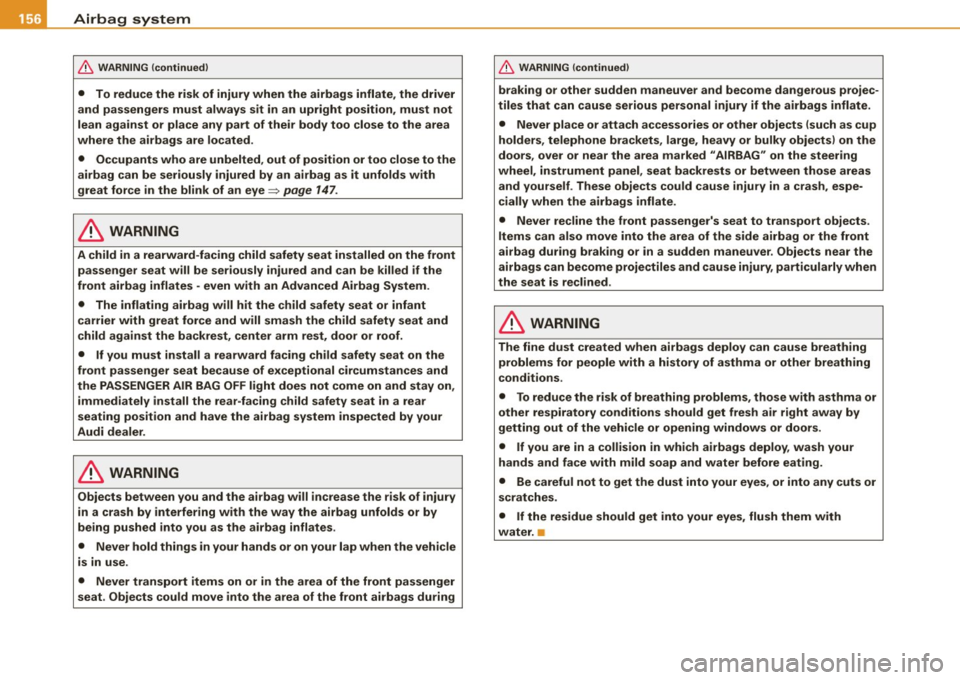
-Airbag system ----=---'---------------------------------------------
& WARNING (continued)
• To reduce the risk of injury when the airbags inflate, the driver
and passengers must always sit in an upright position, must not
lean against or place any part of their body too close to the area
where the airbags are located .
• Occupants who are unbelted, out of position or too close to the
airbag can be seriously injured by an airbag as it unfolds with
great force in the blink of an eye~ page
147.
& WARNING
A child in a rearward -facing child safety seat installed on the front
passenger seat will be seriously injured and can be killed if the
front airbag inflates -even with an Advanced Airbag System .
• The inflating airbag will hit the child safety seat or infant
carrier with great force and will smash the child safety seat and
child against the backrest, center arm rest, door or roof.
• If you must install a rearward facing child safety seat on the
front passenger seat because of exceptional circumstances and
the PASSENGER AIR BAG OFF light does not come on and stay on ,
immediately install the rear -facing child safety seat in a rear
seating position and have the airbag system inspected by your
Audi dealer .
& WARNING
Objects between you and the airbag will increase the risk of injury
in a crash by interfering with the way the airbag unfolds or by
being pushed into you as the airbag inflates .
• Never hold things in your hands or on your lap when the vehicle
is in use .
• Never transport items on or in the area of the front passenger
seat . Objects could move into the area of the front airbags during
& WARNING (continued)
braking or other sudden maneuver and become dangerous projec
tiles that can cause serious personal injury if the airbags inflate.
• Never place or attach accessories or other objects (such as cup
holders, telephone brackets, large , heavy or bulky objects) on the
doors , over or near the area marked "AIRBAG" on the steering
wheel, instrument panel , seat backrests or between those areas
and yourself . These objects could cause injury in a crash, espe
cially when the airbags inflate .
• Never recline the front passenger's seat to transport objects .
Items can also move into the area of the side airbag or the front
airbag during braking or in a sudden maneuver . Objects near the
airbags can become projectiles and cause injury, particularly when
the seat is reclined.
& WARNING
The fine dust created when airbags deploy can cause breathing
problems for people with a history of asthma or other breathing
conditions.
• To reduce the risk of breathing problems , those with asthma or
other respiratory conditions should get fresh air right away by
getting out of the vehicle or opening windows or doors .
• If you are in a collision in which airbags deploy, wash your
hands and face with mild soap and water before eating .
• Be careful not to get the dust into your eyes, or into any cuts or
scratches .
• If the residue should get into your eyes , flush them with
water. •
Page 159 of 316

Monitoring the Advanced Airbag
System
Airbag monitoring indicator light t!
Two separate indicators monitor the function of the
Advanced Airbag System: the airbag monitoring indica tor
light and the
PASSENGER AIR BAG OFF light.
The Advanced Airbag System (including the e lectronic control unit ,
sensor circu its and system w iring) is monitored cont inuously to
make sure that it is functioning proper ly whenever the ignition is on.
Each time you turn on the ignition, the airbag monitoring in dicator
light
r~ will come on for a few seconds (self diagnostics) .
The sy stem mu st be in spe cted wh en the ind icat or
light ~:
• does not come on when the ignition is switched on ,
• does not go out a few seconds after you have switched on the
ignit ion , or
• comes on whi le driving.
I f an airbag system malfunction is detected, the indicator light will
f irst start flashing to catch the driver 's attention and then stay on
continuously to serve as a constant reminder to have the system
inspected immediately .
I f a malfunction occurs that turns the front airbag on the passenger
side off , the
PAS SEN GER AIR BAG OFF light will come on and stay on
whenever the igni tion is on .
& WARNING
An airbag system that is not fun ctioning properly cannot provide
s upplementa l p rotect ion in a front al cr ash.
• If the airbag ind icator light come s on , it mean s that ther e m ay
be something wr ong with the Adv anced Airb ag S ystem . It i s
Safety first
Airb ag sy ste m
& W ARNING !continued )
possible t hat the airbag will inflate when it is not suppo sed to , or
will not infl ate w hen it should.
• Have the airb ag sys tem in spe cted immedi ate ly b y your Aud i
de aler. •
PASSENGER AIR BAG OFF light
)
Fig . 133 S ection from
th e instrum ent pa nel:
PASS ENGER AIR BAG
OFF light
The PASSENGER AIR BAG OFF ligh t is located in the center of the
ins trumen t panel
~ fig . 133.
The
PASSENGER AIR BAG OFF l ight will come on and stay on to tel l
you when the front Advanced Airbag on the passenger side has
been turned off by the electronic control unit. Each time you turn on
the ignition, the
PA SSE NGER AIR BAG OF F light wi ll flash for a few
seconds and :
• will stay on if the fron t passenger seat is not occupied,
• will stay on if there is a small child or child restraint on the front
passenger seat,
• will go out if the front passenger seat is occupied by an adult as
registered by the weigh t-sensing mat .
The
PA SSENGER AIR BAG OFF light mu st come on and stay on if the
ign ition is on and ._
Vehicle care I I irechnical data
Page 161 of 316

__________________________________________________ A_ i_ r _b _a...; g::- s_ y=--- s_t _e _m __ lffl!III
under the upho lstery of the seat have been removed from th e front
p assenge r sea t,
• a safety belt extender has not been left in the safety be lt latch for
the fr ont pass enge r se at .
I n addition to the PASSENGER AIR BAG OFF l ight in the center of the
instrument pane l, the message PASSENGER AIR BAG OFF or
PASSENGER AIR BAG ON will br iefly appear in the instrument c luster
display . Thi s is to inform the drive r of the current front passenger
a ir b ag status .•
Important safety instructions on monitoring
the Advanced Airbag System
& WARNING
An airbag system that is not functioning prope rly cannot prov ide
supplemental protection in a frontal crash.
• If the airbag ind icator light comes on , it means that there may
be something wrong with the Advanced Airbag System . It is
possible that the airbag will inflate when it is not supposed to , or
will not inflate when it should.
• Have the airbag system inspected immediately by your Audi
dealer.
& WARNING
If the front airbag inflates , a child without a child restraint, in a
rearward-facing child safety se at or in a forward-facing child
restraint that has not been properly installed will be seriously
injured and can be killed.
• Even though your vehicle is equipped with an Advanced Airbag
System , make certain that all ch ildren , especially 12 years and
younger, always ride on the back seat properly restrained for their age and size .
Controls and equip ment Safety first
Vehicle operation
& WARNING (continued )
• If you must in stall a rearward-facing child safety seat on the
front passenger seat because of exceptional circumstances and
the PASSENGER AIR BAG OFF light does not appear and stay on ,
immediately install the rear -facing child safety seat in a rear
seating posit ion and have the airbag system inspected by your
Audi dealer .
• A tight tether or other strap on a rearward-fa cing child restraint
attached to the front passenger seat can put too much pressure
on the weight-sensing mat in the seat and reg ister more weight
than is actually on the seat. The heavier weight registered can make the system work as though an adult were on the seat and
deploy the Advanced Airbag when it must be suppressed causing
serious or even fatal injury to the child .
• If, in exceptional circumstances, you must in stall a forward
fac ing child restra int on the front passenger seat , always move the
seat into its rearmost position in the seat's fore and aft adjust
ment range , as far away from the airbag as possible. The backrest
must be adjusted to an upright position . Make sure that the
PASSENGER AIR BAG OFF light comes on and stays on all the time
whenever the ignition is switched on .
& WARNING
• If the PASSENGER AIR BAG OFF light does not go out when an
adult is sitting on the front passenger seat after taking the steps
described above, have the airbag system inspected by your Audi
dealer before transporting anyone on the front passenger seat .
[ i ] Tips
I f the wei ght -sens ing mat in the front passenger seat detects an
empty seat, t he fron t airbag o n the pa ssenge r sid e wil l be tu rne d
o ff , and PASSENGER AIR BAG OFF will stay on .•
Vehicle care Do-it-yourself service Technical data
Page 164 of 316
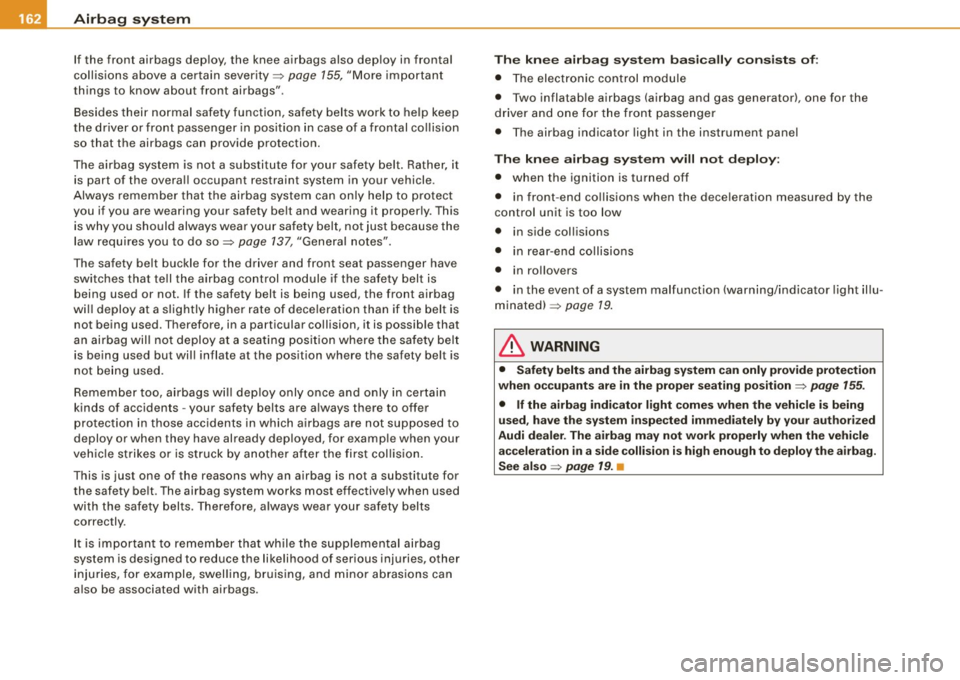
___ A_ ir_ b_ a-g _ s_y _s_ t_ e_ m _________________________________________________ _
If the front airbags deploy, the knee airbags also deploy in frontal
collisions above a certain severity=:>
page 155, "More important
things to know about front airbags".
Besides their normal safety function, safety belts work to help keep
the driver or front passenger in position in case of a frontal collision
so that the airbags can provide protection.
The airbag system is not a substitute for your safety belt. Rather, it
is part of the overall occupant restraint system in your vehicle .
Always remember that the airbag system can only help to protect
you if you are wearing your safety belt and wearing it properly. This
is why you should always wear your safety belt, not just because the
law requires you to do so=:>
page 137, "Gene ral notes" .
The safety belt buckle for the driver and front seat passenger have
switches that tell the airbag control module if the safety belt is
being used or not. If the safety belt is being used, the front airbag
will deploy at a slightly higher rate of deceleration than if the belt is
not being used. Therefore, in a particular collision, it is possible that
an airbag will not deploy at a seating position where the safety belt
is being used but will inflate at the position where the safety belt is
not being used .
Remember too, airbags will deploy only once and only in certain
kinds of accidents -your safety belts are always there to offer
protection in those accidents in which airbags are not supposed to
deploy or when they have already deployed, for example when your
vehicle strikes or is struck by another after the first collision.
This is just one of the reasons why an airbag is not a substitute for
the safety belt . The airbag system works most effectively when used
with the safety belts. Therefore, always wear your safety belts
correctly.
It is important to remember that while the supplemental airbag
system is designed to reduce the likelihood of serious injuries, other
injuries, for example, swelling, bruising, and minor abrasions can
also be associated with airbags . The knee airbag system basically consists of:
• The electronic control module
• Two inflatable airbags (airbag and gas generator), one for the
driver and one for the front passenger
• Th e airbag indicator light in the instrument panel
The knee airbag system will not deploy:
• when the ignition is turned off
• in front-end collisions when the deceleration measured by the
control unit is too low
• in side collisions
• in rear-end collisions
• in rollovers
• in the event of a system malfunction (warning/indicator light illu
minated) =:>
page 19.
&, WARNING
• Safety belts and the airbag system can only provide protection
when occupants are in the proper seating position=:>
page 155.
• If the airbag indicator light comes when the vehicle is being
used, have the system inspected immediately by your authorized
Audi dealer. The airbag may not work properly when the vehicle
acceleration in a side collision is high enough to deploy the airbag.
See also =:>
page 19. •
Page 166 of 316
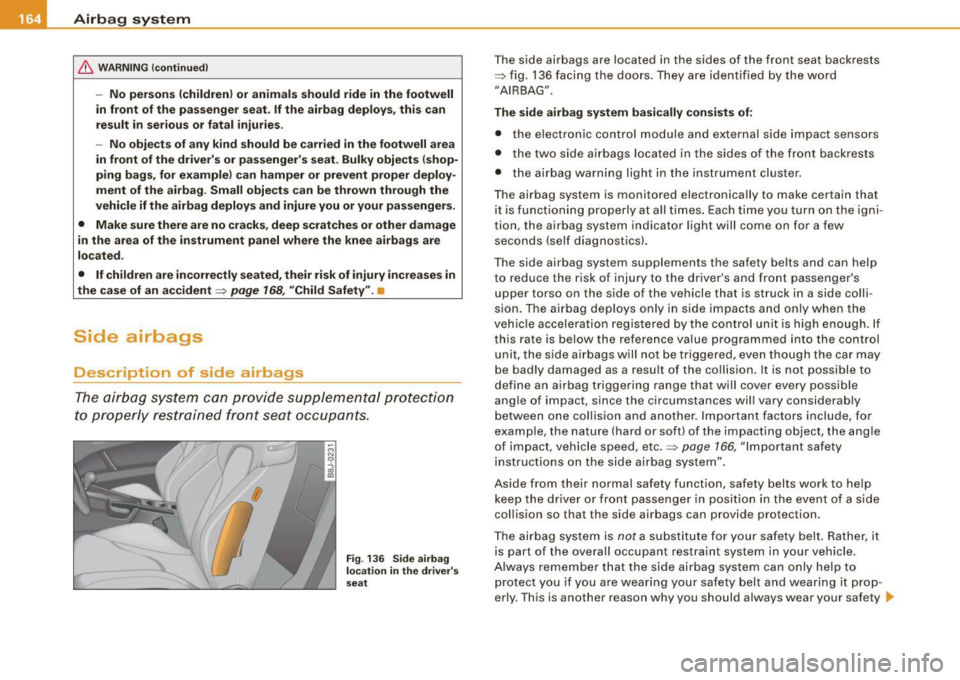
__ .....:.A..:..::..:. ir-=b :....:a=- g=- s= y-=s -=t -=e -=m.;._;_ ________________________________________________ _
& WARNING (con tinued )
-No persons (children ) or animals should ride in the footwell
in front of t he passenger s eat . If the airbag deploy s, thi s can
result in serious or fatal injuries .
- No objects of any kind should be carried in the footwell area
in front of the driver's or pa ssenger' s seat. Bulky objects (shop
ping bag s, for example ) can hamper or prevent p roper deploy
ment of the airbag . Small objects can be thrown through the
vehicle if the airbag deploys and injure you or your passenger s.
• Make sure there are no cra cks , deep scratches or other damage
in the area of the in strument panel where the knee airbags are
located .
• If ch ildren are incorrectly seated , their risk of injury increases in
the case of an accident =>
page 168, "Child Safety". •
Side airbags
Description of side airbags
The air ba g s ystem c an pro vid e sup plemen tal p ro tection
to p rope rly re straine d front seat occup ants.
Fig . 13 6 Side airbag
locat ion in the driver 's
seat
T he side airbags are located in the sides of the front seat backrests
=> fig . 136 facing the do ors. T hey ar e id en tified by the word
"AIRBAG ".
The side airbag system basically consists of :
• the e lec tro nic c ontrol m odule an d ex ternal sid e im pact sens ors
• the two side airbags located in the sides of the front backrests
• the airbag war ning light in the instrument clus ter .
T he airbag system is monitored electronicall y to make certain that
it is functioni ng properly at all times . Each time you turn on the igni
tion, the airbag system indicator light will come on for a few
se co nds (self diag nostics).
The side airbag system supplements the safety belts and can help
to reduce the risk of injury to the drive r's and fr ont passenger's
upper torso on the side of the vehicle that is struck in a side co lli
s ion. The ai rbag deploys only in side impacts and only when the
vehic le acc ele ration re gis te red by the control unit is high eno ugh . If
this rate is below the refe rence va lue programmed into the control
unit, the s ide airbags will no t be tr iggered, ev en thoug h the car may
be badly damaged as a resu lt of the co llision. It is not possible to
de fin e an ai rb a g trigge ring r ange t hat wi ll cov er ev er y possible
angle of impact , since the circumstances will vary considerab ly
bet ween one collision a nd an othe r. Importa nt fac tors include, fo r
example, the na ture (hard or soft) of the impacting object, the ang le
o f im pact, vehicle speed , et c.
=> p age 166, "Importan t safety
i nstructions on th e side airba g sys tem".
Aside from their normal safety function, safety belts wo rk to h elp
ke ep the drive r or front passenger i n pos ition i n th e ev ent o f a side
col lision so that the side ai rbags can provide pro tec tion .
T he airbag system is
not a su bstit ute for y our sa fety belt . Ra the r, it
is part of the overa ll occupa nt restrain t system in your vehicl e.
A lwa ys reme mber tha t the side ai rbag sys tem can only help to
pro tect you if you are w ear ing your sa fety bel t and wear ing it prop
e rly. Th is is another reason why you should always wear your safety .,